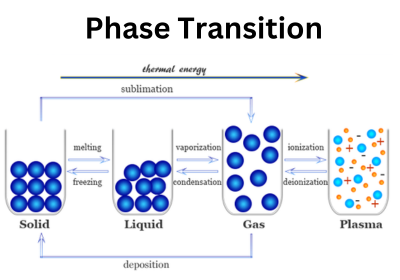Phase transitions refer to the changes between the different phases of matter that occur when energy (usually in the form of heat) is added or removed from a system.

The main types of phase transitions are:
- Melting.
- Freezing.
- Vaporization.
- Condensation.
- Sublimation.
- Deposition.
- Ionization.
- Recombination or Deionization.
Melting (Fusion):
Solid to liquid transition, occurring when a substance absorbs heat and the temperature reaches the melting point.
Example: Ice melting to water at 0°C.
Freezing (Solidification):
Liquid to solid transition, occurring when a substance loses heat and the temperature drops to the freezing point.
Example: Water freezing to ice at 0°C.
Vaporization (Boiling or Evaporation):
Liquid to gas transition, occurring when heat is added and the temperature reaches the boiling point.
Example: Water boiling to steam at 100°C (at 1 atm pressure).
Condensation:
Gas to liquid transition, occurring when a gas cools down and loses heat.
Example: Steam condensing into water.
Sublimation:
Solid to gas transition without passing through the liquid phase, typically occurring at low pressure and temperature.
Example: Dry ice (solid CO₂) sublimating directly to gas.
Deposition:
Gas to solid transition, the reverse of sublimation.
Example: Frost forming on a cold window as water vapor turns directly into ice.
Ionization:
Gas to plasma transition, occurring when a gas is heated to the point where atoms lose electrons and become ions.
Example: Plasma formation in a neon light.
Recombination (De-ionization):
Plasma to gas transition, where ions and electrons recombine into neutral atoms or molecules.
The above 8 are the common phase transitions occur in phase of matter such as solid,liquid,gas and plasma.
Also Read:
- Phase Diagrams.
- Triple Point.
